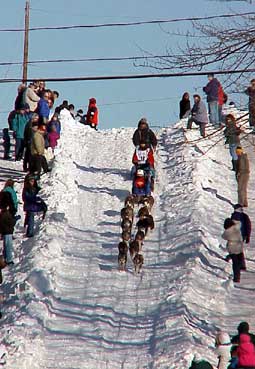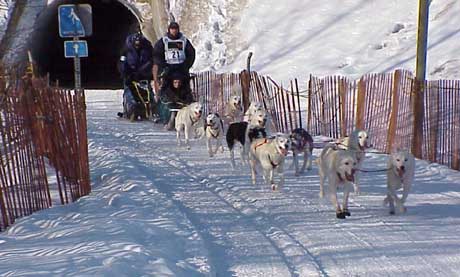 The
Iditarod The
Iditarod
Not all the challenges for Iditarod racers are to be found in the Bush. Mushers and their teams must descend this steep hill in Anchorage before leaving the city's streets for its trail system.
The race starts on Fourth Avenue in downtown Anchorage on a
Saturday morning in early March.
Mushers and dog handlers, their teams and equipment, fill Fourth
Avenue and adjoining side streets for blocks. Spectators crowd
sidewalk barricades, watching as the racers make last-minute
adjustments and try to calm dogs that are anxious to get started.
Some of the teams will have to wait for hours before it's their turn. A team leaves the starting area every three minutes.
The first day's race is just for fun. Mushers carry passengers
-- some of whom are celebrities -- for this part of the race.
But it will be just the mushers and their dogs after the restart
on Sunday in Willow, a few miles north of Wasilla. (In 2003 and again in 2015, because of poor snow conditions,
the restart was moved hundreds of miles north to Fairbanks.) Just as spectators line the streets
and trails along the race route through Anchorage, there will
be a crowd of thousands at the scene of the restart on Sunday.
After that, the mushers will see well-wishers only when they
pass through the occasional village on their thousand-mile trip
to Nome.
The Iditarod attracts visitors in the summer, too, long after the race is over. Wasilla, known as the Home of the Iditarod, houses the Iditarod Museum.
At the start, the typical team has 16 dogs (teams used to be
able to have as many as 20). When it arrives in Nome a week-and-a-half
or so later, there may be only 10 or 12. Mitch Seavey, the winner
in 2004, finished the race with eight dogs. Lance Mackey, who
completed the run in 9 days, 5 hours, 8 minutes and 41 seconds
in 2007, finished with nine dogs. (Mackey won again in 2008, 2009 and 2010.) Veterinarians periodically
check the condition of the dogs along the way, and if they or
the musher feels a dog should not continue, it is removed from
the team and flown back to Anchorage. If a dog looks like it
no longer wants to run while the team is still on the trail,
it'll probably get a ride to the next checkpoint bundled up
on the dog sled. Then it will fly back to Anchorage on one of
the light planes of what's called "the Iditarod Air Force"
after it has been checked by a veterinarian. About 1,400 dogs ran in the 2008 race.
Seventy-one teams (that works out to 1,136 dogs) started the 2010 race. The numbers were down a bit and so was the purse ($561,000) for the top 30 finishers. (In 2013 the purse was $600,000.) The purse in 2010 was a little more than $300,000 less than what those finishers had won in 2009. Still, 19 of the top 20 finishers from 2009 were back, including Mackey,who won this time in eight days, 23 hours, 59 minutes and 9 seconds. It was only the second time the winner had finished in less than nine days. In 2011, the first two finishers completed the race in times that beat the previous record. The winner, John Baker, reached Nome with a team of 10 dogs in eight days, 19 hours, 46 minutes, 39 seconds. That was three hours faster than the previous record. Ramey Smith was just 64 minutes behind him. Sixty-five teams started the 2013 race.
Weather is always an important factor in the race. In 2007, for example, high winds, rough trail and the cold took a toll on the mushers. On March 18, 15 days after the start of that year's race, 47 teams had finished, 12 were still
on the trail, and 23 had dropped out. In 2011, relatively warm weather was taking a toll, forcing some of the early favorites to lag or drop out. 2014 was another rough year. Little or no snow in some places along the trail forced 11 of the 69 mushers out of the race with injuries or broken sleds in the first three days. Another nine mushers dropped out before the race ended.
The race is described as being 1,049 miles long, but it isn't. The 49 in that figure is a reference to Alaska's status as the nation's 49th state. The race alternates between a northern and a southern route. The southern route is 987 miles long. The northern route is 975 miles long.
Below, a team running on the trail system in Anchorage emerges from a tunnel beneath a four-lane road. The trail system is popular with cross-country skiers in the winter, as the tracks indicate.

|